Thoracic spine exercises are key to feeling youthful throughout every season of life. In fact, all spine strengthening and lengthening exercises help to keep you feeling young.
If your spine is strong, mobile, and resilient, your body will feel youthful no matter your age! As Joseph Pilates, creator of the Pilates method, once said: “If your spine is inflexibly stiff at 30, you are old. If it is completely flexible at 60, you are young.”
Focusing on spine health with Pilates has been key to avoiding back pain (even throughout multiple pregnancies!) and minimizing my scoliosis pain for nearly 20 years. In this case, however, we’re talking about the thoracic spine, which is also referred to often as your upper back.
A little bit of science for you: this part of the spine extends from the base of your neck to just below your ribs, making it the longest section of the spinal column! Its 12 vertebrae allow you to bend, stretch, twist, and perform some of the most basic tasks in life.
I know “spine health” doesn’t sound sexy, but if you want to keep your body young and healthy, you have to think about it. So let’s dig into why a healthy thoracic spine, in particular, is so important for keeping your body mobile and pain-free. Plus, you’ll learn how to strengthen it with a quick but effective Pilates routine.

Why a Healthy Thoracic Spine Matters
Your thoracic spine acts as a stabilizer for the neck (cervical spine) and lower back (lumbar spine). It also protects the organs and musculoskeletal structure in other areas surrounding the spine like your chest, shoulders, ribs, core, and pelvis.
If the thoracic spine is flexible, you can move more freely, without pain or restriction. But if it’s weak, stiff, or misaligned, you can struggle from a limited range of motion. You may notice the latter if you feel stiffness or pain in your back after you’ve been sitting for long periods of time. When we sit hunched over a computer (like you might even be doing right now—no judgment here, I do it too!), we put excess pressure on the spine, which can cause feelings of tightness, restriction, and sometimes pain.
This doesn’t mean you can never sit at a computer. It just means it’s important to prioritize intentional and regular movement and strengthening. This helps your spine feel good every day, no matter what you’re doing.
Another perk of taking care of your thoracic spine? Better posture! When you care for your spine you’ll stand and walk taller, which is not only more comfortable but also contributes to improved confidence. You’re also more resilient and mobile, making it easier to play with the children or animals in your life or do activities you love, like hiking or gardening.
While there are many ways to maintain strength and mobility in your spine, I’ve found Pilates to be one of the most valuable tools for myself and thousands of Lindywell members around the globe.
10 Thoracic Spine Exercises to Strengthen and Lengthen
When doing Pilates, you don’t have to choose specific thoracic spine exercises to build strength in this area of your body because Pilates exercises naturally support the entire spinal column and surrounding muscles.
With that being said, these 10 exercises, which come from the Spine Strengthening Pilates workout in the Lindywell app, were chosen for their particular focus on the spine and thoracic spine. Each exercise is also low-impact. Note that you also don’t need to use a resistance band to reap the benefits of this workout!
Lindywell is the leading platform for Pilates and wellness. Sign up to get instant access to this Pilates workout, plus 200+ more routines designed to help you strengthen your spine and improve your overall physical and mental health. Log into the app if you’re already a member or start your 14-day trial today and see why Lindywell is the BEST place to take care of your body and mind.
Roll Downs
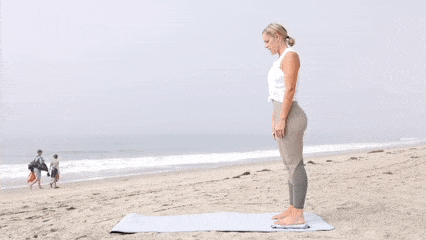
Stand with your feet hip distance apart and the spine tall to relieve any compression. Release tension from your shoulders and nod your chin to your chest, as you slowly roll toward the ground, one vertebra at a time. At the bottom, let your head and arms hang heavy. Take an inhale, and as you exhale, draw your belly toward your spine and slowly roll back up, one vertebra at a time.
Side Bends
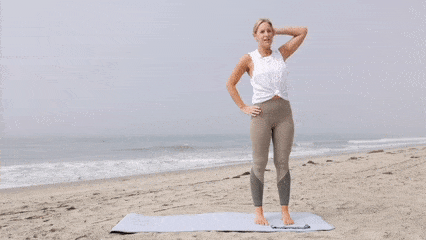
Stand with your feet hip distance apart. Place the left hand on your hip, then place the right hand at the base of your head, bent at the elbow. Inhale as you side bend up and over to the left. Push through the right foot as you stretch to the right to create a deep stretch in your right side.
Use your core muscles to lift your body back to the center. Repeat on the other side.
Shoulder Pulses

Stand with your feet hip distance apart and the spine straight, slight bend in the knees. Place the resistance band just above your wrists and extend both arms straight out in front of you, parallel to the ground. Face your palms toward one another and pulse your arms into the band and back together for a count of 10. Turn the palms down and repeat for another count of 10.
Overhead Pulses
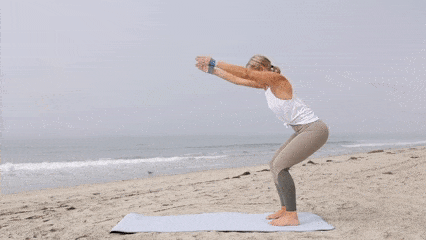
Stand with your feet hip distance apart and hinge at the hips to sit back as if you’re sitting in a chair. Lift the arms up by the ears, palms facing each other, widen your sit bones, and pull your belly button into your spine to protect your back. Draw your shoulders away from your ears and press the arms out into the band for 10 counts.
Pelvic Bridges
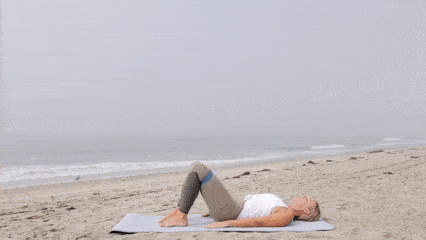
Lie flat on your back, knees bent, feet flat on the floor. Loop your resistance band around your thighs, just above the knees. Rest your head on the floor and your arms at each side and let your collarbone fall open.
Draw the belly button in toward your spine and articulate your spine up into a bridge position. Pause at the top, then roll back down. Roll back up into a bridge and pulse the thighs out, stretching the band for a count of 10 before rolling back down.
Roll-Ups
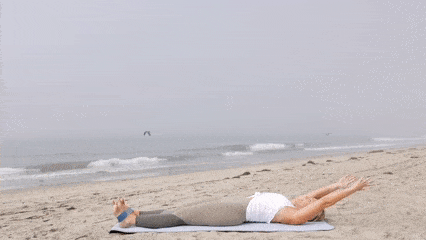
Lie on your back with both legs parallel and straight in front of you. Move the resistance band down to the outside of your feet and pull the legs out from your midline to create slight tension in the band.
Raise both arms overhead by the ears, then use your core muscles to lift the head, neck, and chest up off the mat and toward your feet. Inhale as you lift your head, neck and chest up off of the mat. Exhale as you continue rolling up to stretch forward beyond your toes. Think about holding a beach ball on your lap as you do this—you want to stretch forward, over the feet, not down toward the ground. Inhale at the top and as you exhale lower yourself down to the mat one vertebra at a time. Repeat 8-10 times.
Spine Stretch Forward

Begin in a seated position, with your legs extended in front of you, open to the width of your mat. Place the resistance band just above your wrists. With light tension in the band, extend both arms parallel in front of you and articulate the spine forward, stretching beyond your toes. Flex the feet and imagine you are pressing them into a wall in front of you. As you roll back up to a seated position, imagine that you are stacking your spine up against a wall behind you. Repeat 8-10 times.
Spinal Twists
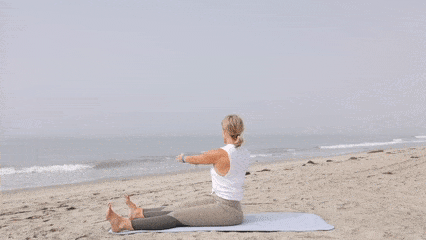
Sit with your legs at a wide V-shape angle and your spine straight. Extend both arms parallel in front of you and keep the resistance band around each wrist with your palms facing toward one another. Flex the feet and press your heels out, as if you’re pushing against a wall. At the same time, sit tall as if there’s a wall behind your back as well.
From this position, rotate your torso over to the right side, with both arms still parallel and slight resistance in the band. Return through the center, then rotate your torso over to the left side before returning back to center again.
Thoracic Spine Exercises to Keep Your Spine Young
No matter how old you are, age is just a number when your spine is flexible, strong, and resilient. While spine health may not be the sexiest topic, it’s critical if you want to feel good at every age. These thoracic spine exercises, and most others that we do in Pilates, support your spine, so you can enjoy each and every moment of life.




